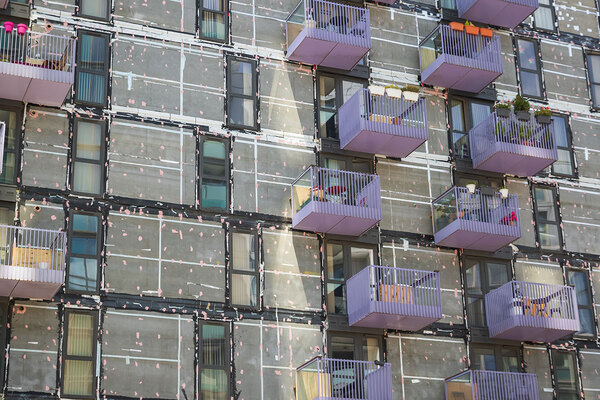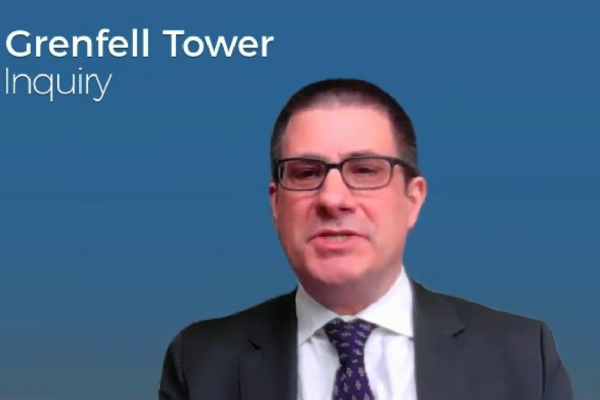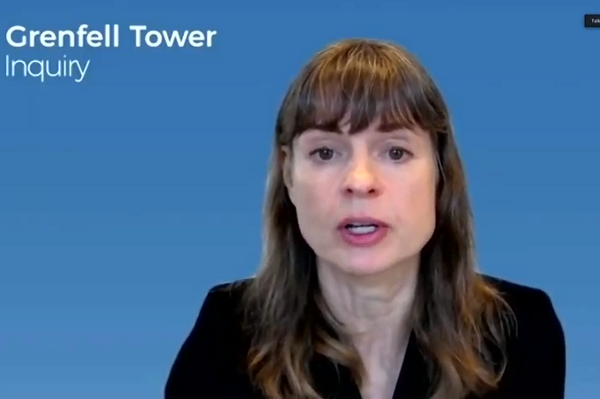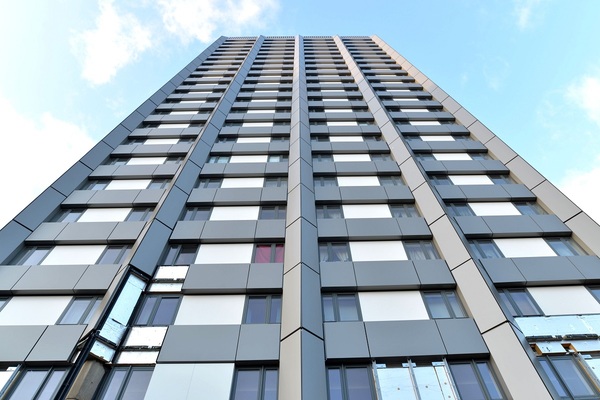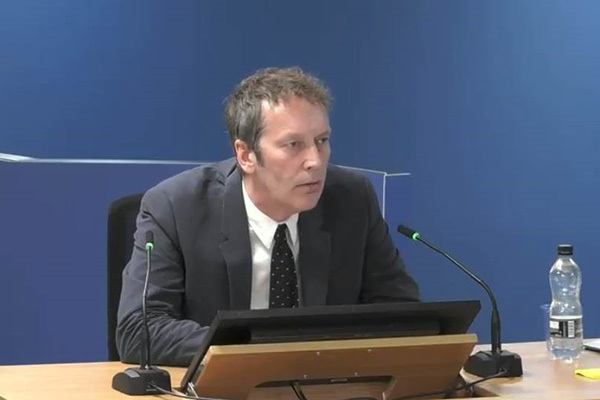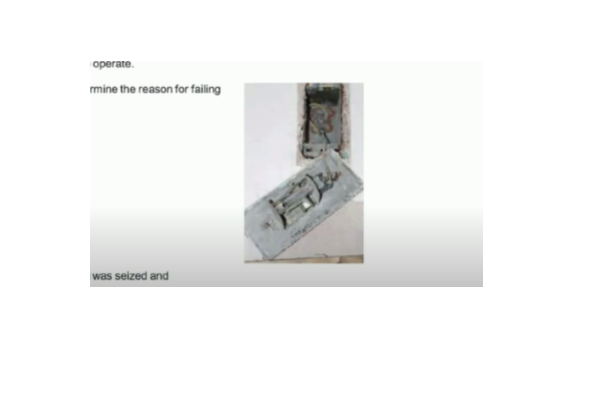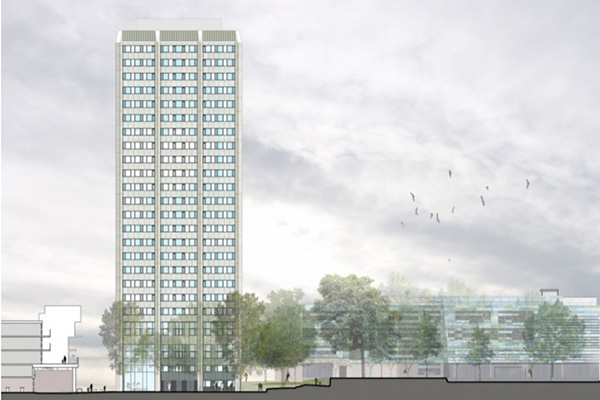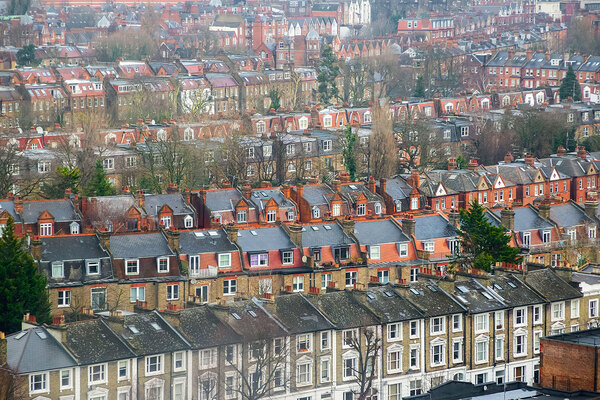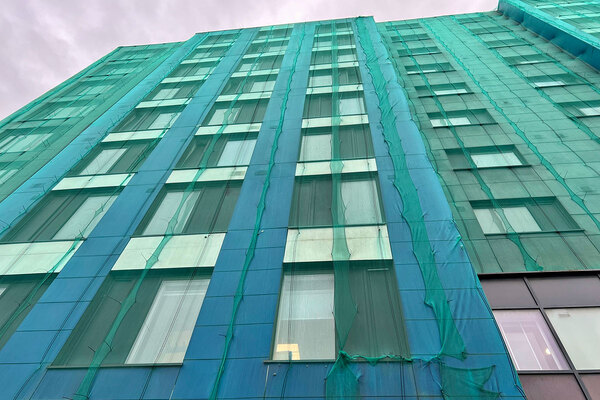Grenfell Tower Inquiry diary week 30: ‘There is certainly a high probability that in the event of another fire the whole building can become an inferno’
The focus of the inquiry shifted this week to the actions of the social housing providers responsible for maintaining Grenfell Tower. Peter Apps recaps what we learned
A new section of the Grenfell Tower Inquiry began this week, with opening statements delivered for its third module, which will put the spotlight on the social housing providers: the Royal Borough of Kensington and Chelsea (RBKC) and its management company Kensington and Chelsea Tenant Management Organisation (KCTMO).
The inquiry will break its analysis into three parts: fire safety complaints made by residents before the fire and how they were dealt with, the extent to which the organisations complied with their legal obligations, and the ‘active and passive’ fire safety measures within the tower (which means things such as fire doors, smoke extraction and lifts).
Let us look at each of those topics in turn.
‘The invidious choice of bearing the burden of speaking up alone or being silent’
That residents complained of fire safety defects and warned of catastrophe before the disaster has been part of the story since hours after the blaze.
This week we learned how far back they went. Shah Ahmed, a resident of the 18th floor and chair of the Grenfell Tower Leaseholders Association, wrote a stark letter to KCTMO as early as September 2010.
A fire in a lobby had filled the building with smoke, and Mr Ahmed was worried about the consequences of a repeat. “As you know fire does not kill as much as the effects of smoke and to our knowledge some of the residents nearly died due to smoke inhalation and suffocation,” he wrote.
“Grenfell Tower with its interior staircase and malfunctioning ventilation system there is certainly a high probability that in the event of another fire the whole building can become an inferno.”
The smoke ventilation system remained defective on the night of the fire seven years later and a number of residents died in the stairwell, with many others unable to escape because of the smoke.
Danny Friedman QC, (pictured above) appearing for one group of survivors, said resident participation at KCTMO “was at most tokenistic or, more often, suppressed whenever there was disagreement” and he quoted from KCTMO documents to say that it believed the primary purpose of involving residents in the refurbishment was to win “buy-in and support for the project”.
He pointed to the refusal to provide project minutes to resident Edward Daffarn in October 2014 “by blanket indication of commercial sensitivity”. But he said an internal KCTMO document showed that the refusal was to avoid “critical scrutiny of problems”.
“As you know fire does not kill as much as the effects of smoke and to our knowledge some of the residents nearly died due to smoke inhalation and suffocation”
Claire Williams, project manager for KCTMO, cited the “bombshell” of residents remaining unprotected due to a non-functioning ventilation system despite a deficiency notice from the London Fire Brigade (LFB), something she said would “cause Mr Daffarn to raise more queries either on his blog or via further freedom of information requests”.
Mr Friedman described an “obsessive defensiveness” towards Mr Daffarn, which extended to KCTMO refusing to fix a broken self-closer that he reported in a neighbour’s flat. This remained unfixed on the night of the fire, with smoke filling the floor as a result. Two residents of the floor died, and Mr Daffarn only narrowly escaped.
When residents tried to form a group, with the support of trade union Unite in early 2015, KCTMO would not even meet with it. And a petition against the refurbishment signed by 60 residents only resulted in a review run by KCTMO that praised their own work.
Mr Friedman said that KCTMO assumed residents were being led by Mr Daffarn and other vocal critics, rather than possessing their own negative views.
“It ought to be obvious to anyone involved in social housing that residents may be reluctant to complain personally for a multitude of reasons, including but in no way limited to immigration or housing status, or experience as a member of a minority race or ethnicity,” he said.
“They must be entitled to rely on collective advocacy, rather than be given the invidious choice of bearing the burden of speaking up alone, being silent or indeed silenced.”
Reference was made to a number of specific complaints – including about broken door closers – which will be addressed in detail as the evidence progresses.
Michael Mansfield QC, appearing for another group of survivors, emphasised the case of an unnamed resident who went six months without a functioning toilet despite KCTMO knowing he had bowel cancer.
However, James Ageros QC, appearing for KCTMO, painted a very different picture. He said the ‘Grenfell Action Group’ blog – of which Mr Daffarn was one author – was in “vehement opposition” to a project to build a school near the tower and this may have “soured the relationship between some tenants and the TMO”.
“The inquiry may wish to consider whether views expressed by some more vociferous residents were truly representative of the views of a majority of residents,” he said.
He said complaints handling “was always a priority for the TMO” and its performance was “monitored both internally and externally”.
Much will be learned about this process in the weeks to come.
‘It is surely a landmark act of discrimination against disabled and vulnerable people’
A crucial element of the legal duties imposed on RBKC and KCTMO is the responsibility to identify vulnerable residents in Grenfell Tower and plan for their escape.
There is no dispute that this was not done. The question is going to turn on whether it should have been.
Families’ lawyers were united in their criticism of the council and KCTMO on this point. “The lack of appropriate precautions is reflected in the deaths,” said Stephanie Barwise QC (pictured above).
She said that a quarter of the 67 child residents present on the night died and that 41% of the 37 vulnerable adults died – higher death rates than in any other group. However, a spreadsheet sent to the LFB on the night of the fire listed only 10 residents with disabilities of 225 identified.
Ms Barwise said that KCTMO and risk assessor Carl Stokes were aware of the need to provide emergency evacuation plans and the fact that they had not done so.
She said that Mr Stokes advised against participation in an LFB pilot of sprinklers for vulnerable people as this would raise the question: “Why they were not included in the [fire risk assessment]?”.
Ms Barwise and others emphasised that Article 15 of the Regulatory Reform (Fire Safety) Order required building owners to produce an evacuation plan and Article 9(7)(b) required the risk assessment to record “any group of persons identified by the assessment as being especially at risk”.
Mr Friedman called the fire “a landmark act of discrimination against disabled and vulnerable people” and Mr Williamson said it showed “a flagrant disregard for residents’ safety”.
But a complicating factor is the existence of guidance written for the Local Government Association (LGA) in 2011 following the Lakanal House fire, with the endorsement of government and the housing sector, which said it was “usually unrealistic” for landlords to prepare personal emergency evacuation plans for vulnerable residents.
This was noted by lawyers for both RBKC and KCTMO, with Mr Ageros saying the guidance “largely determined [KCTMO’s] policy, including its approach towards personal emergency evacuation plans”.
This feeds into a major theme of the opening statements. The author of the LGA guide was Colin Todd, who is also a key expert witness for this phase of the inquiry.
His views were said to be in “sharp contrast” to the other expert witness, Dr Barbara Lane, and lawyers for the families criticised Mr Todd. Mr Williamson went as far as saying that his clients “do not accept that he is an appropriate expert to guide the inquiry”.
But both RBKC and KCTMO cited his evidence with approval in their opening statements, and RBKC emphasised the need for awareness of general industry practice with regard to its decision to follow the guidance.
Whatever the rights and wrongs of doing so, it is certainly the case that many social landlords placed great emphasis on the guidance and did not develop evacuation plans for vulnerable residents.
‘He lacked any professional registration and invented some of his professional qualifications’
Another key focus of this module will be the advice given by risk assessor Carl Stokes. Ms Barwise said KCTMO placed its reliance on him “for all aspects of fire safety advice at Grenfell”.
But she added that he “lacked any professional registration and invented some of his professional qualifications”. We did not get much more detail on the invented qualifications this week, although that will undoubtedly be examined when Mr Stokes gives evidence.
Again, Dr Lane and Mr Todd were said to be at odds over Mr Stokes’ performance, with Dr Lane issuing some sharp criticism but Mr Todd defending his performance.
This was queried by Ms Barwise, who said aspects of Mr Todd’s report “create the impression [he] is at pains to exonerate Stokes”.
Lawyers representing both KCTMO and RBKC spoke in favour of Mr Todd’s views, however, with Mr Ageros saying “he is an expert in fire risk assessment, which Dr Lane, although eminent, is not”.
The question of his lack of registration – not for the first time in this inquiry – points to a potential broader failure in the fire safety net before Grenfell. There was no requirement for registration at all, with no regulation of those who carried out risk assessments.
“The sector was and remains completely unregulated,” said James Maxwell-Scott QC for RBKC (pictured above). “No qualifications are required by law. No training is required by law. There was and is no bar whatsoever to anyone seeking to go into business as a fire risk assessor.”
‘He did not know what the composition of the cladding was and therefore had not assessed the risks posed by it’
A particular aspect of Mr Stokes’ work that will face scrutiny is what he said about the tower’s cladding (pictured above), which he described as “fire rated” in his assessment. This was described as a “meaningless term” by Ms Barwise, who said that Mr Stokes has now accepted “he did not know what the composition of the cladding was and therefore had not assessed the risks posed by it”.
There will be a legal question – addressed in an opening statement for the London Fire Commissioner – about whether the external walls were required to form part of the risk assessment. Nonetheless, since Mr Stokes did offer an opinion, that opinion will be scrutinised.
This came up in April 2017, just weeks before the fire, when the LFB wrote to all London boroughs warning of a recent fire in Shepherd’s Bush and advising them to check the compliance of their building facades through risk assessments.
This email was forwarded to Janice Wray, head of health and safety at KCTMO, who forwarded it to Mr Stokes.
“Grenfell was clad but the cladding complied with the requirements of the building regulations,” he wrote in an email sent from his mobile. “Lots of questions asked of Rydons and answers received back from them.”
The appropriateness of this advice and the weight placed on it is likely to be a major theme with the relevant witnesses.
‘How can we best transfer responsibility for maintenance of door-closers on to the tenants?’
Two major issues surround fire doors. The first is the broken or missing self-closers. The second is that the doors themselves were later found to be defective.
The first of these was a crucial fire safety flaw at Grenfell Tower, with smoke pouring from open doors into lobbies and later the stairs.
Families’ lawyers explained this week that Grenfell was left in this state despite the council and KCTMO receiving a sharp warning of the risks following a fire at nearby Adair House in 2015. In this instance, a broken self-closer led to smoke filling the lobby and many residents being trapped – although the blaze was non-fatal.
“RBKC therefore had full knowledge of the extensive fire risks posed by the lack of door-closers, yet failed to commit to install closers across its estate until nearly two years after it had seen the serious consequences of this omission,” said Ms Barwise.
Even when it did commit to doing so, in March 2017, Laura Johnson, director of housing, is said to have pushed to make it a five-year rather than a three-year programme “to make the funding more manageable”. She also pushed against ongoing monitoring, calling it “an additional expense to the [Housing Revenue Account] indefinitely”.
Peter Maddison (pictured above), director of assets and regeneration at KCTMO, was said to have sought legal advice on whether door closers were only needed “where fundamental to the fire strategy” and wrote in an October 2016 email: “How can we best transfer responsibility for maintenance of door-closers on to the tenants?”
RBKC now accepts that a programme of door-closer replacement should have been adopted sooner.
But even with working door closers, the fire doors were not appropriate. Tests after the fire showed them failing at 15 minutes rather than the required 30.
These doors were provided by Manse Masterdor, which supplied 106 replacement doors in Grenfell Tower between 2011 and 2013.
Ms Barwise’s opening statement said that Manse Masterdor had signed a contract to supply doors with an 's' rating, which meant they would protect against smoke leakage. In fact, they had never been tested to this standard.
They also only tested them from one side despite a legal requirement to test both, and only tested two variations of the doors despite marketing 28.
Mr Ageros, for KCTMO, questioned why the inquiry has decided not to call Manse witnesses to give evidence and asked them to reconsider.
‘Stokes’ treatment of lifts was deplorable’
This module of the inquiry will also dedicate time to the tower’s defective smoke ventilation system and why it was not fixed. This was plainly a serious problem, which had been known about for years, and expert evidence will be called to help explain it.
The lifts are another major issue. The lifts were not firefighters’ lifts, despite being identified as such in Mr Stokes’ risk assessment, a mistake Ms Barwise described as “deplorable”.
We also heard a challenge from Martin Seaward QC, representing the Fire Brigades Union, to the suggestion that firefighters may have been unable to take control of these lifts on the night of the fire because they used the wrong-sized key.
Mr Seaward presented evidence (shown above) which he said demonstrated instead that the mechanism was clogged with dust and debris, something he said may have occurred during the refurbishment.
What’s next?
The inquiry now breaks for Easter and will resume on 19 April with the first evidence from residents.
It is planning to resume in-person hearings, bringing an end to the Zoom-enabled remote hearings that have been in place since the New Year.
Grenfell Tower Inquiry: week 30 headlines
The Grenfell Tower fire was a “landmark act of discrimination against disabled and vulnerable people”, lawyers acting for survivors and bereaved have said, as they outlined a series of failures made by the council and its managing agent in the build-up to the blaze.
Sadiq Khan brands handling of resident complaints ‘a disgrace’ in statement to inquiry
Sadiq Khan has branded “the dismissive treatment” of complaints made by Grenfell Tower residents “a disgrace” in an opening statement to the inquiry on his behalf.
Grenfell Tower Inquiry phase two: weekly diaries
Module one: the refurbishment
Week one: A vivid picture of a broken industry
After a week of damning revelations at the opening of phase two of the Grenfell Tower Inquiry, Peter Apps recaps the key points
Click here to read the full story
Week two: What is the significance of the immunity application?
Sir Martin Moore-Bick has written to the attorney general requesting protection for those set to give evidence at the Grenfell Tower Inquiry. Peter Apps explains what the move means
Click here to read the full story
Week three: Architects of misfortune
This week saw the lead architects for the Grenfell Tower refurbishment give evidence to the inquiry. Peter Apps runs through the key points
Click here to read the full story
Week four: ‘I didn’t have any perception that it was the monster it’s become’
The architects continued to give evidence this week, outlining a lack of understanding of the fire risk posed by the cladding materials and its design. Nathaniel Barker reports
Click here to read the full story
Week five: ‘No adverse effect in relation to external fire spread’
As the Grenfell Tower Inquiry returns from its long absence, Peter Apps recaps the key points from a week of important evidence from the fire consultants to the refurbishment
Click here to read the full story
Week six: ‘I can’t recall any instance where I discussed the materials with building control’
Nathaniel Barker summarises what we learned from fire engineers Exova, architects Studio E and the early evidence from contractor Rydon
Click here to read the full story
Week seven: ‘I do not think I have ever worked with a contractor operating with this level of nonchalance’
Two key witnesses from contractor Rydon gave evidence this week. Peter Apps recaps some of the key points from a revealing week of evidence
Click here to read the full story
Week eight: ‘It haunts me that it wasn't challenged’
Four witnesses from contractor Rydon gave evidence this week. Lucie Heath recaps what we learned on the last week of evidence before the inquiry breaks for five weeks
Click here to read the full story
Week nine: ‘All I can say is you will be taken out for a very nice meal very soon’
This week the inquiry heard evidence from witnesses at Harley Facades, the sub-contractor responsible for Grenfell Tower’s cladding. Peter Apps recaps the key points
Click here to read the full story
Week 10: ‘As we all know, ACM will be gone rather quickly in a fire!’
As the Grenfell Tower Inquiry entered its 10th week, Jack Simpson recaps the key points from a week of important evidence from the refurbishment’s cladding contractor
Click here to read the full story
Week 11: ‘Did you get the impression Grenfell Tower was a guinea pig for this insulation?’
With witnesses from the cladding subcontractor, the firm which cut the deadly panels to shape and the clerk of works which inspected the job giving evidence this was week full of revelations. Peter Apps recaps the key points
Click here to read the full story
Week 12: ‘Would you accept that was a serious failing on your part?’
With the surveyor who inspected Grenfell Tower for compliance giving evidence, this was a crucial week from the inquiry. Dominic Brady and Peter Apps report
Click here to read the full story
Week 13: ‘Value for money is to be regarded as the key driver for this project’
With consultants to Kensington & Chelsea Tenant Management Organisation (KCTMO) giving evidence, attention at the Grenfell Tower Inquiry turned for this first time to the actions of the TMO and the council. Peter Apps reports
Click here to read the full story
Week 14: ‘Did it not occur to you at this point that your budget was simply too low?’
This week, for the first time in phase two, the inquiry heard from Kensington & Chelsea Tenant Management Organisation, the landlord that oversaw the fatal refurbishment of Grenfell Tower. Lucie Heath reports
Click here to read the full story
Week 15: ‘Have you ever informed the police that you destroyed documents relevant to their investigation?’
Witnesses from the Kensington and Chelsea Tenant Management Organisation (KCTMO) gave evidence for a second week, which began with a shocking revelation about withheld and destroyed evidence. Peter Apps recaps
Click here to read the full story
Week 16: ‘I conclude this was very serious evidence of professional negligence’
This week saw members of Kensington & Chelsea Tenant Management Organisation finish giving evidence, before the inquiry’s expert witnesses took the stand to make some highly critical assessments of the work they had seen before and during the refurbishment of Grenfell Tower. Jack Simpson recaps
Click here to read the full story
Grenfell Tower: a timeline of the refurbishment
Following the conclusion of module one of the Grenfell Inquiry’s second phase, Peter Apps presents a timeline of the key moments during the fatal refurbishment of the west London tower block
Click here to read the full story
Module two: the cladding products
Week 17: ‘It’s hard to make a note about this because we are not clean’
The start of the second module of the Grenfell Tower Inquiry phase two came with some huge revelations about the companies that sold the products used in the cladding system. Peter Apps reports
Click here to read the full story
Week 18: ‘It was just reckless optimism wasn't it?’
As the inquiry began cross-examining witnesses for the second module of its phase two work, the picture surrounding just how Grenfell Tower ended up wrapped in such dangerous materials became a little clearer. Nathaniel Barker was keeping an eye on proceedings
Click here to read the full story
Week 19: ‘And that was intentional, deliberate, dishonest?’
The Grenfell Tower Inquiry this week heard the shocking story of how the insulation manufacturer “manipulated” official testing and marketed its product “dishonestly”. Peter Apps tells the story
Click here to read the full story
Week 20: ‘We were outed by a consultant who we then had to fabricate a story to’
This week the inquiry investigated the actions of Kingspan – the manufacturer of one of the insulation products used in the tower’s cladding system. Dominic Brady reports
Click here to read the full story
Week 21: ‘It’s there in black and white isn't it? We see a complete absence of any consideration of life safety’
The story of insulation giant Kingspan’s testing and marketing of its combustible insulation for high rises was unpacked in minute detail this week. Peter Apps reports
Click here to read the full story
Week 22: ‘All we do is lie in here’
In the third week of evidence from insulation giant Kingspan, the inquiry continued to uncover shocking details about the firm’s behaviour both before and after the Grenfell Tower fire. Lucie Heath reports
Click here to read the full story
Week 23: ‘That would have come as an earthquake to you at the time, would it not?’
This week the inquiry took its deepest dive yet into the inner workings of the cladding manufacturer whose product has been blamed for the terrible spread of fire up Grenfell Tower. Nathaniel Barker reports
Click here to read the full story
Week 24: ‘Do you accept that Test 5B was Arconic's deadly secret’
The president of the firm that made and sold the cladding panels installed on Grenfell Tower was asked to account for the apparent concealment of “disastrous” fire tests on the product this week. Peter Apps reports
Click here to read the full story
Week 25: ‘This is quite an incredible list of omissions and missed instances, isn’t it?’
This week the Grenfell Tower Inquiry heard its first witnesses from the Building Research Establishment (BRE) - the testing house which carried out key fire tests on the Kingspan and Celotex insulation products which were later used on Grenfell Tower. Peter Apps reports.
Click here to read the full story
Week 26: 'You were taking an enormous risk, weren't you?'
Week 26 at the Grenfell Tower Inquiry was a key moment in understanding how dangerous products used on the tower came to be accepted by industry professionals. Dominic Brady reports
Click here to read the full story
Week 27: ‘What will happen if one building made out [of] PE core is in fire and will kill 60 to 70 persons?’
The most explosive evidence this week at the Grenfell Tower Inquiry came from those who did not attend, as the evidence which would have been presented to Arconic witnesses was displayed in their absence. Peter Apps reports
Click here to read the full story
Week 28: ‘This is a serious safety matter’
This week the Grenfell Tower Inquiry zeroed in on the British Board of Agrément, the body that produced “misleading” certificates which inspired trust in both the cladding and insulation used on the tower. Lucie Heath reports
Click here to read the full story
Week 29: ‘Is it true that Kingspan’s position… was to do its best to ensure that science was secretly perverted for financial gain?’
The final week in this section of the Grenfell Tower Inquiry primarily examined the attempts by insulation manufacturer Kingspan to lobby government after the fire. Peter Apps reports
Click here to read the full story
How the products used in Grenfell Tower's cladding system were tested and sold
As the section of the Grenfell Tower Inquiry examining how the products used in the cladding system were tested, marketed and sold comes to a close, Peter Apps summarises what we have learned about each of the products included in the system
Click here to read the full story
Module Three: the management of the tower
Week 30: ‘There is certainly a high probability that in the event of a fire the whole building can become an inferno’
The focus of the inquiry shifted this week to the actions of the social housing providers responsible for maintaining Grenfell Tower. Pete Apps recaps what we learned
Click here to read the full story
Week 31: ‘If we cannot get out people will die’
This week saw the former residents of Grenfell Tower enter the witness box to tell of their experiences attempting to raise complaints with the council and its managing agent. Pete Apps reports
Click here to read the full story
Week 32: ‘Let's hope our luck holds and there isn't a fire’
This week saw the return of the landlord of Grenfell Tower, Kensington and Chelsea Tenant Management Organisation (KCTMO), as senior staff members attempted to explain how vital fire safety protections at the block were allowed to fall into disrepair. Lucie Heath reports
Click here to read the full story
Week 33: ‘Isn't that a serious gap in the scope of a policy meant to safeguard vulnerable people?’
A slightly disjointed week at the Grenfell Tower inquiry saw further evidence from staff at building manager Kensington and Chelsea Tenant Management Organisation (KCTMO) interspersed with the views of a cladding expert. Peter Apps reports
Click here to read the full story
Week 34: ‘Some members of the community are doing their best to spread false information’
Jack Simpson covers all the major revelations from the past week of evidence at the Grenfell Inquiry, including evidence from Laura Johnson, director of housing at the Royal Borough of Kensington and Chelsea.
Click here to read the full story
Week 35: ‘I really didn’t like the champagne’
This week the Grenfell Tower Inquiry saw council witnesses, including former deputy leader Rock Feilding-Mellen and leader Nicholas Paget-Brown, questioned about their role in the story for the first time. Peter Apps reports
Click here to read the full story
Week 36: ‘Is that not a very incurious approach for a fire risk assessor?’
This week the Grenfell Tower Inquiry scrutinised the work of Carl Stokes, the man hired to carry out fire risk assessments for the block. Nathaniel Barker reports
Click here to read the full story
Week 37: ‘In giving that advice, weren’t you acting beyond your knowledge and expertise?’
A curtailed week at the Grenfell Tower Inquiry saw fire risk assessor Carl Stokes grilled over advice he gave regarding the tower’s cladding. Peter Apps reports
Click here to read the full story
Week 38: ‘Well it’s a bit more than that, isn’t it. He’s suggesting that you tell the LFB a lie’
The inquiry heard the mammoth cross-examination of KCTMO’s health and safety manager Janice Wray this week. Peter Apps reports
Click here to read the full story
Week 39: ‘What you said there was a grotesque understatement’
This week the inquiry continued to hear from former employees of Kensington and Chelsea Tenant Management Organisation, as well as two employees from the London Fire Brigade. Lucie Heath reports
Click here to read the full story
Week 40: ‘An exercise in concealment and half-truth’
Former KCTMO chief executive Robert Black gave his evidence to the inquiry this week and was asked to account for the various failures described over the previous six weeks. Peter Apps and Nathaniel Barker report.
Click here to read the full story
Week 41: ‘We should do nothing. This is not the sort of website we should be responding to’
This week saw the return of Robert Black, chief executive of Kensington and Chelsea Tenant Management Organisation (KCTMO), before the inquiry turned its attention to the defective smoke control system in the tower. Dominic Brady reports
Click here to read the full story
Week 42:‘They would leak as much as they leaked. They were what they were’
The Grenfell Tower Inquiry continued its in-depth investigation of the tower’s non-compliant smoke control system this week, with evidence from the various contractors involved in delivering it. Pete Apps reports
Click here to read the full story
Week 43:‘Contractors at the time were not generally aware of the importance of leaving holes unsealed’
This week the inquiry focused on two of the more overlooked areas of the Grenfell Tower fire, with evidence focusing on the gas pipelines and lifts within the west London block. It was a packed week, with five witnesses giving evidence. Jack Simpson reports
Click here to read the full story
Week 44:‘I've never seen a fully compliant firefighting lift in any local authority building, to this day actually’
This week the inquiry turn the focus onto the building’s defective lifts, with evidence from an expert, contractors who worked on them and a former engineer at KCTMO. Pete Apps reports.
Click here to read the full story
Week 45: ‘Don’t you find all this rather a surprising debate, given that the Equality Act was passed in 2010?’
The inquiry heard from expert witness Colin Todd this week, who gave his views about the work of risk assessor Carl Stokes as well as answered questions about his own guidance. Peter Apps and Nathaniel Barker report
Click here to read the full story
Week 46: ‘I think I've been very, very clear that is completely wrong’
This week the inquiry heard further expert evidence about fire risk assessor Carl Stokes’ actions, as the section of its work covering the management and maintenance of the tower concluded. Peter Apps reports
Click here to read the full story
Six key failures in the way Grenfell Tower was managed before the fire
Peter Apps recaps some of what we have learned about the actions of the Royal Borough of Kensington and Chelsea (RBKC) and Kensington and Chelsea Tenant Management Organisation (KCTMO) in the years before the fire.
Module one and two closing statements
Week 47: ‘An unedifying spectacle’
After a week of closing statements from the core participants involved in modules one and two, Lucie Heath recaps the key arguments of each group
Click here to read the full story
Module five: the fire brigade
Week 48: ‘They knew, and lives could and should have been saved’
The phase of the Grenfell Tower Inquiry examining the actions of the London Fire Brigade in the years before the fire kicked off this week with some major revelations. Peter Apps reports
Click here to read the full story
Week 49: ‘I'm not sure we've always taken every opportunity to learn as an organisation’
How the London Fire Brigade acted upon lessons from incidents in the years before the Grenfell Tower disaster came under the microscope this week at the public inquiry. Nathaniel Barker reports
Click here to read the full story
Week 50: ‘There is a culture in LFB that is very conservative. I think there is great comfort in what is familiar’
This week the inquiry heard how the London Fire Brigade (LFB) elected not to issue warnings about dangerous cladding before Grenfell and a detailed examination of its policy for checking high risk buildings. Pete Apps reports.
Click here to read the full story
Week 51:‘We teach firefighters to expect building failure’
An unusually brief week of evidence at the Grenfell Tower Inquiry explored how a fire service neighbouring London was taking a different approach to tackling blazes in high rises. Nathaniel Barker reports
Click here to read the full story
Week 52: ‘I actually think that there is a measure of incompetence at all levels’
Expert evidence concluded the current section of the inquiry with some stinging criticism of the London Fire Brigade (LFB). Pete Apps and Grainne Cuffe report.
Click here to read the full story
Module six: fire services
Week 53: ‘They make for chilling reading and harrowing listening’
The inquiry’s investigation into central government began this week with lawyers setting out their view on how and why firefighting policies failed. Peter Apps and Lucie Heath report
Click here to read the full story
Week 54: ‘Our consideration of evacuation at this time was something of a blind spot’
The development of policy on ‘stay put’, both nationally and for London, occupied the attention of the inquiry this week. Peter Apps reports
Click here to read the full story
Week 55: ‘My review is pretty scathing!’
In a week that included the 200th day of evidence in phase two of the inquiry, attention turned to the London Fire Brigade’s control room. Lucie Heath reports
Click here to read the full story
Week 56: ‘Why didn't we thump the table harder’
This week, the control room at the London Fire Brigade was examined further – both before and after the fire. Pete Apps and Lucie Heath report
Click here to read the full story
Week 57: ‘It was worse than slow, it was sluggish’
Former London Fire Brigade (LFB) commissioner Dany Cotton was the star witness this week, as the inquiry continued to delve into the brigade’s knowledge and training before the Grenfell Tower fire. Jack Simpson, Grainne Cuffe and Pete Apps report
Click here to read the full story
Week 58: ‘I don't think we deserve to ask for trust until we demonstrate different outcomes’
A current and former commissioner of the London Fire Brigade (LFB) wrapped up the inquiry’s investigation into the actions of the brigade before the fire. Grainne Cuffe and Peter Apps report.
Module six: testing and government
One of the major scandals of our time: key revelations as the Grenfell Tower Inquiry turns to government
The government was accused of “covering up” the risks of dangerous cladding as its “unbridled passion for deregulation” left it a “junior party” to the construction industry as the latest phase of the public inquiry opened today. Peter Apps summarises some of the main points
Click here to read the full story
Week 59: ‘Recent tests have apparently shown it continued to burn for 20 minutes after the flame was taken away’
After shocking opening statements, the Grenfell Tower Inquiry turned its attention to the work of Local Authority Building Control. Pete Apps reports
Click here to read the full story
Week 60: ‘You could have an exact repeat of the Dubai fire in any number of buildings in London’
The Grenfell Tower Inquiry turned its attention to the work of the National House Building Council this week, with shocking revelations about the extent of the warnings issued to central government before the fire. Peter Apps reports
Click here to read the full story
Week 61: ‘Mistakes are meant for learning, not repeating’
In the first hearings of the new year, the Grenfell Tower Inquiry heard closing statements from the firefighting section of phase two. Lucie Heath reports
Click here to read the full story
Week 62: Did it ever occur to you that this act of collaboration was, in one sense, corrupting?
The Grenfell Tower Inquiry returned to the work of the National House Building Council (NHBC) this week, with a new shocking revelation about the government’s actions in the immediate aftermath of the fire. Peter Apps reports
Click here to read the full story
Week 63: ‘It came after the general move to deregulation. So more regulation was not welcome’
The government’s focus on deregulation before the Grenfell Tower fire was placed in the spotlight this week with a series of shocking revelations about its failure to amend fire safety guidance. Pete Apps and Grainne Cuffe report
Click here to read the full story
Week 64: ‘I didn’t think ACM would be suitable for use in any high-rise buildings. I don’t think anyone did’
This week, the Building Research Establishment’s Dr Sarah Colwell gave more than three days of evidence, with some huge revelations about what was known about the dangers of aluminium composite material years before the fire and the mass confusion over the government’s building regulations. Peter Apps and Jack Simpson report
Click here to read the full story
Week 65: ‘Unless the government does something now about ACM panels, people will die’
Further evidence from the Building Research Establishment and the first government witnesses added new depth to our understanding of how warnings were missed before the Grenfell Tower fire. Peter Apps reports
Click here to read the full story
Week 66: ‘Was there a cover-up?’
The latest evidence from the Grenfell Tower Inquiry tracked the government’s failure to act on fire safety warnings right up until the months before the fire. Peter Apps and Grainne Cuffe report
Click here to read the full story
Week 67: ‘When exposed to a fire, the aluminium melts away and exposes the polyethylene. Whoosh!’
This week the inquiry heard disturbing new evidence about the failure of senior government officials to act on warnings about dangerous cladding in the years before the Grenfell Tower fire. Peter Apps reports
Click here to read the full story
Week 68: ‘Can we agree that was a pretty dangerous thing to have, all this falling on one man’s shoulders?’
Three senior civil servants gave evidence this week, including the official who had responsibility for building regulations guidance on fire safety in the years before Grenfell. Peter Apps, Lucie Heath, Stephen Delahunty and Grainne Cuffe report
Click here to read the full story
Week 69: ‘It was just unthinkable. You had the makings here of a crisis you could not comprehend’
This week, civil servant Brian Martin gave his long-awaited evidence to the Grenfell Tower Inquiry. Peter Apps reports
Click here to read the full story
Week 70: ‘Show me the bodies’
An important week at the Grenfell Tower Inquiry saw a dramatic conclusion to the mammoth cross-examination of civil servant Brian Martin, as well as the first politicians. Peter Apps and Lucie Heath report
Click here to read the full story
Week 71: ‘I have changed my schedule to fit this in. I do have an extremely busy day meeting people’
Three politicians who were responsible for building regulations before Grenfell appeared before the inquiry this week, including the former communities secretary Eric Pickles, who responded to the coroner’s letter following the Lakanal House fire. Peter Apps and Lucie Heath report
Click here to read the full story
Module Four: aftermath
Week 72: 'The system isn't broken. It was built this way'
This week the inquiry turned to the shocking story of the lack of support for bereaved and survivors in the immediate aftermath of the Grenfell Tower fire. Peter Apps, Lucie Heath, Grainne Cuffe and Jack Simpson report
Click here to read the full story
Week 73: ‘Most people would regard that as hopeless’
This week, the Grenfell Tower Inquiry heard about the Royal Borough of Kensington and Chelsea’s chaotic response in the immediate aftermath of the blaze, from the staff responsible for it. Pete Apps, Stephen Delahunty and Grainne Cuffe report
Click here to read the full story
Week 74: ‘Do you agree that RBKC was ill-prepared and incapable to meet its duties’
This week, Nicholas Holgate, former chief executive of the Royal Borough of Kensington and Chelsea, was grilled on his failure to hand over control of the aftermath of the fire, despite the borough’s lack of capacity. Peter Apps reports
Click here to read the full story
Week 75: ‘It still shocks me to the core that that’s how we treat our citizens in this country’
This week the inquiry heard witnesses from the housing management body discuss their role in the aftermath of the Grenfell Tower fire, followed by a range of witnesses from other organisations which supported the response. Peter Apps and Grainne Cuffe report
Click here to read the full story
Week 76: ‘I fear this will become our New Orleans’
This week the inquiry heard from central government figures and members of the London-wide emergency response arrangements. Peter Apps and Grainne Cuffe report
Click here to read the full story
Week 77: ‘The planning wasn’t done and there was nothing for us to be drawing on’
The Grenfell Tower Inquiry’s examination of the aftermath of the fire concluded with witnesses from central government. Peter Apps reports
Click here to read the full story
Module seven: expert evidence and closing statements
Week 78: ‘The abandonment of the ‘stay put’ strategy for high-rise residential buildings is essential’
This week the Grenfell Tower Inquiry heard a range of expert witnesses discuss their reports. Peter Apps and Grainne Cuffe report
Click here to read the full story
Week 79: ‘You could argue the system was created to enable people to circumvent the rules’
The Grenfell Tower Inquiry continued to hear expert evidence this week, with two senior figures in the world of fire safety academia criticising the government’s approach before and after the blaze. Peter Apps and Grainne Cuffe report
Click here to read the full story
Week 80: ‘The evidence points to wilful blindness and complacency towards safety’
As the inquiry moves into its final stages, lawyers for the key players gave statements about the evidence surrounding central government. Peter Apps reports
Click here to read the full story
Week 81: ‘This is Islamophobia. It’s racism. It is the elephant staring back at us in the room’
This week, closing statements covering the aftermath of the fire delivered a shocking new revelation and an expert toxicologist gave his views on the causes of the deaths. Peter Apps reports
Click here to read the full story
Module eight: further evidence relating to the deceased
Week 82: ‘Their chance to hear about the circumstances in which their loved ones died is the culmination of five years of waiting’
The Grenfell Tower Inquiry moved into its final module this week, with evidence relating to the circumstances in which the victims died. Peter Apps reports
Click here to read the full story
Week 83: ‘They died together as they lived: caring for one another’
A second week of evidence relating to the circumstances in which the victims of the fire died delivered more heartbreaking stories about their final moments. Peter Apps recaps
Click here to read the full story
Week 84: ‘Every decision affects someone who is an adored child, a beloved sister, a respected uncle, a needed mother’
The final week of oral evidence for the Grenfell Tower Inquiry’s second phase contained more heartbreaking evidence about the deaths in the tower. Peter Apps reports
Click here to read the full story
Closing statements
Week 85: ‘The merry-go-round turns still, the notes of its melody clearly audible in the last few days’
The Grenfell Tower Inquiry returned this week for closing statements from lawyers representing the bereaved and survivors and the various parties under scrutiny for the fire. Pete Apps reports.

